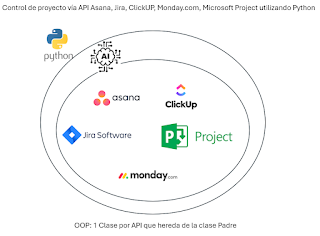Project Management in Electronics Using Artificial Intelligence
Project Management in Electronics
Using Artificial Intelligence
Autor: Francisco
Prats Quílez
1.
Introduction
Currently,
electronics project management is conducted analytically by a project manager,
who must handle tasks such as personnel management, task allocation, time
estimation, and offer generation. This traditional approach can be prone to
human errors and inefficiencies. As a team of engineers begins working on the
development of an electronic product, the complexity and workload can increase
significantly. Artificial Intelligence (AI) has emerged as a powerful tool to
optimize this process, providing innovative solutions that improve efficiency
and accuracy at various project stages. This text examines the implementation
of an AI-based electronics project management system, highlighting its
benefits, challenges, and results.
2- Project Objectives
- Process
Automation: Implement AI models and tools to automate
project processes by analyzing input information and generating output
information efficiently. This process will be managed
through an AI agent.
- Integration
with Project Management Platforms: Use APIs and Python to control
and integrate different engineering project management platforms,
facilitating synchronization and information flow between them.
- Improvement
of Large Language Models (LLM): Address the indeterminacy of
current models using techniques such as Retrieval-Augmented Generation
(RAG), improving the consistency and accuracy of the results generated by
the LLM.
3. Methodology To demonstrate the implementation
of AI in electronics project management, a generic project is structured into
several key phases:
- Initial
Project Phase: High-Level Requirements Analysis – Proposal Presentation In the
initial project phase, clients present a problem for which we must offer a
solution proposal. Different AI agents can assist in this process by
generating summaries of initial meetings or proposing solutions to pending
issues. The following image illustrates how AI models and tools support
each stage of this initial project phase.
- PCB
Hardware Design Phase During the development of a PCB, a hardware
engineer creates the PCB requirements based on the general project
requirements, from which they then develop the PCB. This process includes
several stages, such as creating block diagrams or documenting the hardware
description. Methods like Retrieval-Augmented Generation (RAG) can help in
component selection, datasheet analysis, or schematic review. The
following image provides an example of this phase.
- Product
Validation and Verification Phase In the final phases of the
project, a Validation and Verification (V&V) engineer and a SW Test
engineer can use different AI agents to, for example, select test
instrumentation or develop test software in Python, based on the defined
test cases. The following image shows an example of this phase.
Conclusions The implementation of an AI-based
electronics project management system proved to be an effective solution for
addressing the traditional challenges of the sector. AI's ability to automate
processes, optimize resources, and proactively detect errors resulted in a
significant improvement in project efficiency and quality. This case study
highlights the potential of AI to transform electronics project management.
Future Directions
- Capability
Expansion: Based on the cited demonstration, the project
could be extended to address phases not mentioned in an electronics
project, as well as generalize the initial interpretation to adapt it to
projects in production areas or a predefined work methodology.
- Continuous
Research: Maintain constant research to explore new
applications of AI in electronics project management and adapt to emerging
market trends and new model capabilities.








Comentarios
Publicar un comentario